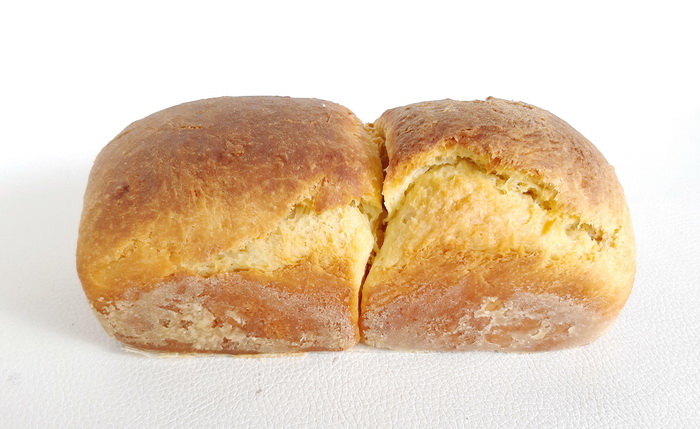
The $600 Brioche Loaf.

The $600 Brioche Loaf.
This is my take on the Sablée Brioche of Modernist Cuisine, the $506, 6 volume cookbook.
You know what Brioche is.
As for Sablée, Wikipedia states :” The French word “sable” means sand, which is the French term that takes the place of the English "breadcrumbs". Generally, the baker begins the process by rubbing cold butter into flour and sugar to form particles of dough until the texture resembles that of breadcrumbs or sand.”
Here the term is used to mean that we want to obtain a crumb with a crumbly, “sandy” (“sablée”) texture. Modernist Cuisine recommends using a food processor for mixing the components; if you don’t have one avail yourself with a pastry blender https://www.youtube.com/watch?v=9I4O4TkSklg. Use your fingers as a last resort since this has the inconvenience of warming the mixture.
The original formula uses instant dry osmotolerant yeast, here it is replaced with normal instant dry yeast increased by 30 %.
Ingredients | Weight | % |
High-gluten bread flour with 12,5% - 13% protein | 290g | 100 |
Butter, unsalted,cold, cut into small cubes * | 145g | 50 |
Sugar | 45g | 15.52 |
Fine salt | 9g | 3.1 |
Instant dry yeast | 6g | 2.10 |
Eggs, cold | 120g | 41.38 |
Whole milk, cold | 65g | 22.41 |
Yield | ± 680g | 234.51 |
* The quality of all ingredients is important but when 50 % of a formula is butter you have to pay special attention to it. All butters are not created equal, their content varies from brand to brand. It is recommended that you use grade AA unsalted butter for baking. That means it’s 18% water, at least 80% butterfat, and 1% to 2% milk solids. Check the label the next time you’re browsing the dairy aisle.
Directions
Put the flour, butter, sugar, salt and yeast in a bowl and combine well by any of the methods mentioned above until the mixture resembles cornmeal; add the eggs and milk and continue to mix until you obtain a homogeneous mass. Lightly oil the bowl and cover it with plastic wrap.
Allow to bulk ferment for 2 ½ hours at room temperature. During this time, develop the gluten in the dough by performing 5 folds, 1 just after mixing and then 1 fold every 30 minutes https://www.youtube.com/watch?v=hO8Kt0r00lo. To check if the gluten has evolved successfully perform the windowpane test on the mixture https://lifehacker.com/use-the-windowpane-test-to-tell-if-your-dough-is-proper-1789963601. If necessary continue folding until you succeed.
After the final fold let the dough rest for 30 minutes, then cover well and refrigerate for 12 to 14 hours.
This dough is intentionally made weak so as to obtain a tender preparation and for this reason it is recommended to divide it into at least two distinct balls per loaf.; this will help the mix to achieve a more uniform shape.
Divide dough into equal parts (use of a bench knife and scale is recommended). Form each part into a boule (ball) and place them seam side down into a loaf pan that has been previously prepared.

A word on pans. In the original publication there is no indication of what size should be used, a very important matter since the right size pan will give you the nicest looking loaf; for this amount of dough I use a 19 cm by 9 cm by 5 cm ( 7 3/8” by 3 5/8” by 2”) pan made of dark metal.
Final proof at room temperature for two to four hours depending on the warmth. Check dough proof by means of indentation test https://www.youtube.com/watch?v=CN3HIIOnTbY.
Baking
Pre-heat home oven to 205°C (400°F).
Place pan in oven and bake for 10 minutes. Reduce temperature to 190°C (375°F), rotate pan and bake for an additional 20-25 minutes. Brioche should be a deep brown when done, should sound hollow when tapped and its internal temperature must reach at least 88°C (190°F) at the center using an instant-read thermometer. (It's easy to underbake, since it browns so quickly!). Remove the brioche from the oven, and after 10 minutes remove it from the pan to cool completely on a rack.

The Crumb

I invite you to visit my blog https://myfoodaddress.blogspot.com/


Many thanks for the recipe and process details - and great looking brioche!
Lance
Thank you very much for your kind words.
how does it taste? Beautiful bake.
To simply say that it tastes very good takes you nowhere. Let’s say that in this bread no flavor is distinctly predominant. It is so slightly sweet that it can be combined with savory elements like turkey ham. At the same time it welcomes raspberry jam. You don’t distinctly taste the butter but rather vanilla tones (although it does not carry that component).
People who have tasted this bread remembers the feel that it leaves in your mouth.
In short you have to taste it yourself. Once you do PLEASE come back to me, will you?
thank you
This is really cool and it looks easier than I expected, thanks for sharing!
Hi Ibor,
Your brioche looks absolutely amazing and the explanation very clear. This is just what I've been looking for. I'm saving this link for future baking.
Thank you very much!
Thank you and best wishes for your baking endeavour.